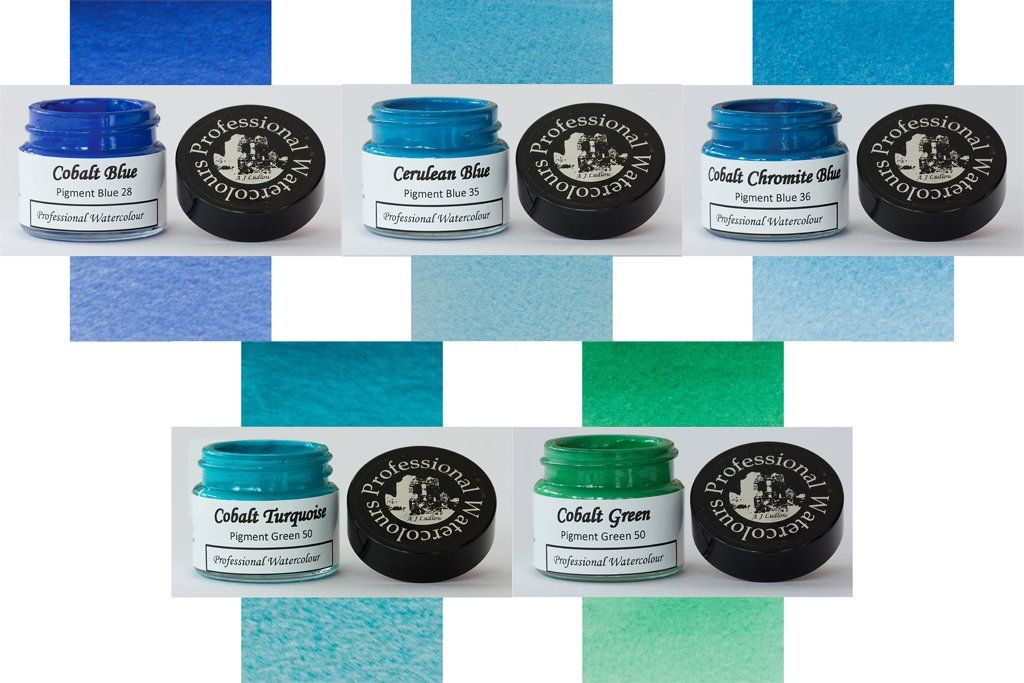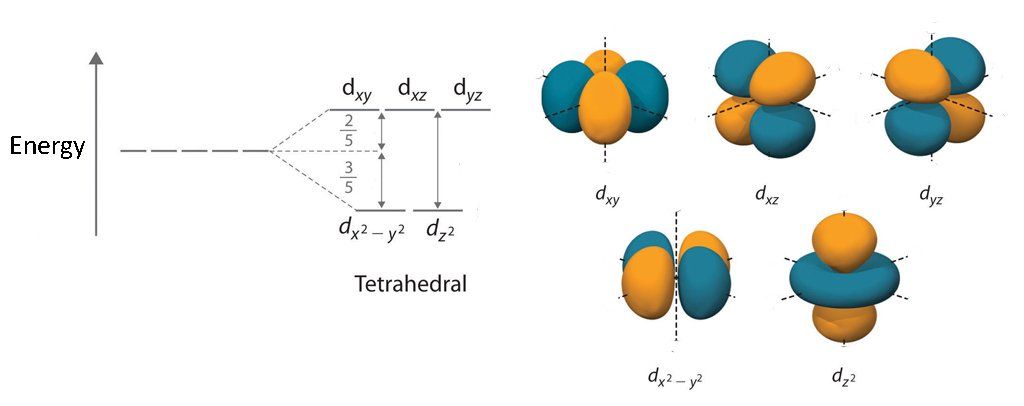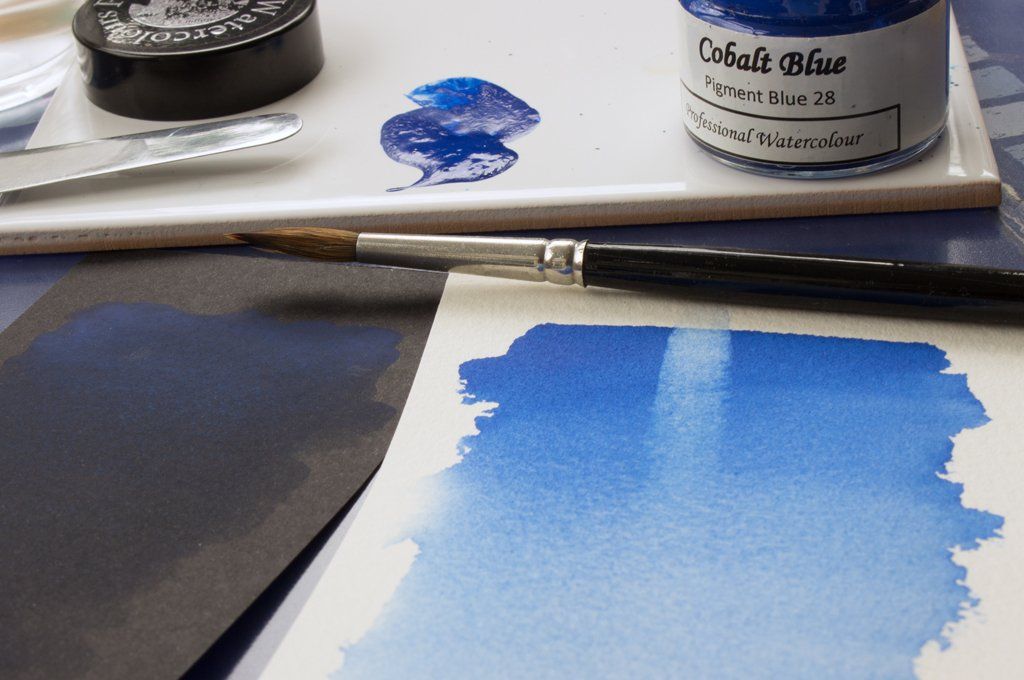ARTicles
Pigment Stories – Cobalt Spinel Blues and Greens.
A periodic look at the stories behind the pigments used in A J Ludlow’s Professional Watercolours

Following on from my earlier ARTicles, spotlighting the pigments used in my professional watercolour range, I would now like to turn our attention to the pigments used in Cobalt, Cerulean, Cobalt Chromite Blues, Cobalt Turquoise and Cobalt Green.
These pigments all share the same lattice structure, which is shown diagrammatically in figure 1. This group of pigments are from a class of minerals known as spinels, which have a general formulation of AB2X4. The mineral crystallises into the cubic (isometric) crystal system, with the X anions (oxygen, denoted as red in figure 1) arrange in a cubic close-packed lattice and the cations A (cobalt, denoted as blue in figure 1) and B (aluminium, denoted as yellow in figure 1) occupy some or all of the octahedral and tetrahedral sites in the lattice (Wikipedia – Spinel Group).

Figure 1: Spinel crystal structure of Cobalt Blue pigment (cobalt (II) aluminate), where the cobalt (II) ions are blue and aluminium (III) ions are yellow (favpng.com)
Much of these cobalt-based mixed metal oxide inorganic pigments have outstanding heat stability and high colour fastness, which are due to the tightly packed spinel lattice. Their colour is due to the ligand field exerted by the oxide on the tetrahedral co-ordinated Co2+ in the spinel lattice, which splits the originally equivalent d-orbitals of the cobalt (II) anion and permits electron transitions between the split levels as a result of light absorption in the visible range (Bittler 1980). Ligand field interactions can explain the bright colours of pigments derived from co-ordination complexes of transition metals (figure 2), which include cobalt. The concept is based on the Crystal Field Theory, which states that the 5 d-orbitals of the outer most electron shell of the transition metal atom are split into 2 sets with different energy levels. When the molecule absorbs a photon of visible light, 1 electron (or more) jumps from the lower energy d-orbitals to the higher ones, creating an excited state. The energy absorbed is related to the energy difference between the 2 electronic states, which in turn is influenced by the strength of the crystal field exerted by the ligands that form the co-ordination complex.

Figure 2: Ligand field interactions in a tetrahedral complex, showing how the crystal field is split and the spatial arrangement of the d-electron orbitals of a transition metal (chem.libretexts.org)
Cobalt Blue
Pigment Details: Cobalt Aluminium Oxide / Colour Index Pigment Blue 28 (C.I. PB28)
Blue pigments derived from cobalt (II) aluminate have been known for centuries; the Chinese used an impure pigment, possibly formed during the firing process, in their “blue and white” porcelain, dating from 14th Century (Yuan dynasty) and on earthenware produced even earlier during the 1st Century (Tang dynasty). The discovery of cobalt blue pigment however, was attributed to Joseph Leithner in Vienna, who developed the basic process of calcining cobalt oxide and alumina (Leithner’s Blue) in 1775 (Pigment Compendium, page 241). Subsequently in 1803, the French Chemist, Louis Jacques Thénard used different cobalt salts in the precipitation process making it easier to obtain the cobalt aluminate pigment. Two processes were developed, one yielded pigment with a deeper blue hue, the other, produced a darker blue. Both shades were known as Thénard’s Blue; a term that was later used to mean simply cobalt blue (Pigment Compendium, page 367). Other names for cobalt blue which reference an inventor, production method or a corruption of the same, include; Gahn’s Ultramarine or Gahn’s Blue, Wenzel’s Blue, Binder’s cobalt blue, Kӧnigsblau (corrupted to Kings Blue*), Leidner and Leyden Blues (corruptions of Leithner’s Blue), New Blue and Dresden Blue.
As stated above, the crystal structure of cobalt (II) aluminate (and other cobalt mixed metal oxide pigments) form a spinel lattice corresponding to the formula CoO-Al2O3, where the four oxygen anions (4O2-) arrange in a cubic close packed lattice and the metals occupy the octahedral (Co2+) and tetrahedral(2Al3+) sites in the lattice (see figure 1). Much of cobalt blue’s outstanding heat stability and high colour fastness are due to this tightly packed spinel lattice.

Figure 3: Graduated washes on white and black paper (showing the transparency) of Cobalt Blue Professional Watercolour and where the colour has been lifted out.
Cobalt blue is considered one of the traditional pigments for watercolour (Mayer 1991, page 136). With respect to colour “temperature”, cobalt blue is generally regarded as a neutral blue (where cerulean blue is for example, regarded as cool and ultramarine blue is warm). The brightness and cleanness of hue makes this pigment the best choice for Cobalt Blue in A J Ludlow’s Professional watercolour range.
Cerulean Blue
Pigment Details: Cobalt (II) Stannate / Colour Index Pigment Blue 35 (C.I. PB35)
Cerulean Blue is traditionally prepared using the mixed metal oxide inorganic pigment, cobalt (II) stannate. Its hue and use by many artists, has led the cerulean blue colour, to be synonymous with blue skies. It is interesting that the word cerulean is derived from the Latin word cӕruleus, meaning “dark blue, blue or blue-green”, which in turn is thought to be a derivative of the word cœlum, meaning heaven or sky (Wikipedia – Cerulean).
The cobalt-tin mixed metal oxide pigment itself has been known by many names. Originally it was known as “Hӧpfner blue”, reported as early as 1789 by the Swiss Chemist Albrecht Hӧpfner in the journal, Magazin für die Naturkunde Helvetiens. In the 1880s, the pigment was referred to as “Coelin” by the German manufacturer; as Cerulium by the British importer, Roberson and later as Coeruleum by the British colourman George Rowney; other names included ceruleum and corruleum (sometimes as cœruleum or cӕruleum) and eventually being known today as cerulean blue (Wikipedia – Cerulean).

Figure 4: Graduated washes on white and black paper (showing the transparency) of Cerulean Blue Professional Watercolour and where the colour has been lifted out.
Cerulean blue is considered one of the traditional pigments for watercolour (Mayer 1991, page 136). With respect to colour “temperature”, the relatively greenish cerulean blue is often regarded as a cool blue (where cobalt blue is for example, regarded as neutral and ultramarine blue is warm).
Cobalt Chromite Blue
Pigment Details: Cobalt Chromium Aluminium Oxide / Colour Index Pigment Blue 36 (C.I. PB36)
The crystal structure of cobalt chromium aluminium oxide is similar to cobalt (II) aluminate (which corresponds to the formula CoO-Al2O3), except in this case, the Al3+ cations are partially replaced with Cr3+ ions. The incorporation of chromium (III) in the lattice gives the pigment its greenish blue hue. The resulting spinel lattice (see for example figure 1) is formed around the oxygen anions (O2-) arrange in a cubic close packed lattice and the metals occupy the octahedral (Co2+) and tetrahedral (Cr3+, Al3+) sites in the lattice.

Figure 5: Graduated washes on white and black paper (showing the transparency) of Cobalt Chromite Blue Professional Watercolour and where the colour has been lifted out.
The cobalt chromium aluminium oxide pigment is often described as “cerulean blue”, but its colour is a greener-shade blue than that of the traditional cerulean, cobalt (II) stannate. This pigment is also used as a cobalt turquoise, due to its greenish shade.
Cobalt Turquoise
Pigment Details: Cobalt Nickel Titanate / Colour Index Pigment Green 50 (C.I. PG50)
In my professional watercolour range, the Cobalt Turquoise watercolour is prepared using the mixed metal oxide inorganic spinel structured pigment, cobalt nickel titanate. The pigment has an intense teal hue and although classified as C.I. Pigment Green 50, the chemical structure and composition of this teal coloured pigment is different to that of the green (see Cobalt Green), which is a complex mixed metal oxide of cobalt, nickel, titanium and zinc.

Figure 6: Graduated washes on white and black paper (showing the transparency) of Cobalt Turquoise Professional Watercolour and where the colour has been lifted out.
Cobalt nickel titanate (which has the molecular formula, Co2NiO7Ti2) has a hue, which is not too dissimilar to the blue-green mineral of the mixed metal hydrated phosphate of copper and aluminium (CuAl6(PO4)4(OH)8 4H2O), which is commonly known as the gemstone, Turquoise. The word turquoise is derived from the French word, turque meaning “Turkish” as the gemstone was originally imported into Europe from Turkey. Similar in some ways to the use of the gemstone lapis lazuli as a blue pigment, turquoise stone from the mines in Sinai, was ground down to make pigment for the artists and scribes of ancient Egypt (Fitzwilliam Museum). The ancient Egyptians called this pigment “Mefkhat” and its colour had considerable significance in their culture, being associated with the goddess Hathor.

Figure 7: Series of colour mixes created with Cobalt Turquoise.
Although the colour turquoise is now associated with hues midway between blue and green, the fact that the watercolour based on this pigment is so similar to the colour to the gemstone turquoise, it was named Cobalt Turquoise. This watercolour is often over looked as a mixing colour, because of its bright and unique hue, but it can be used to create a series of unique light greens and blues, which makes it an ideal part of A J Ludlow’s Professional Watercolour range (figure 7).
Cobalt Green
Pigment Details: Cobalt-Nickel-Zinc Titanate / Colour Index Pigment Green 50 (C.I. PG50)
Cobalt Green is often thought as being synonymous with Rinmann’s (or Rinman’s) Green. It is named after the Swedish chemist, Sven Rinman, who discovered the green cobalt zincate pigment in 1780. The colour is described as a dull yellowish green by the Colour Index, who classify the pigment as C.I. 77335, (pigment green 19) and describe its structure as an “isomorphic mixture of cobalt zincate and zinc oxide which cannot be chemically separated” (Pigment Compendium, page 120). It was an unpopular pigment as it was expensive to buy and not particularly strong (Pigment Compendium, page 329). Rinmann’s Green is also referred to as Zinc Green** and is similar to Gellert Green, which was made by using a different method.











